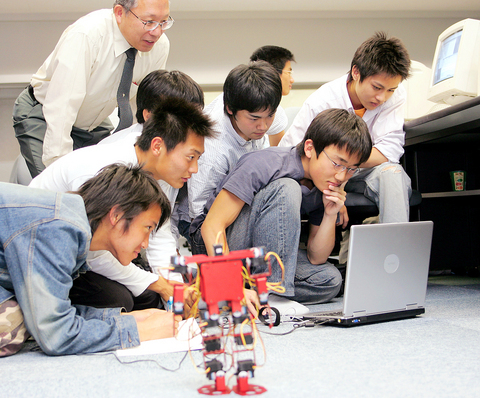Ten teenagers anxiously huddled over a Transformer-like robot in a humble classroom are pioneers in Japan's initiative called "super science" -- a nationwide effort in public education to nurture future leaders in technology.
At a time when fears are growing that Japan is being overshadowed by the clout of China as well as increasingly successful businesses in other Asian nations, hopes are high for the program, which grants high schools money to fund their own original technology curriculum.
Japan, the world's second largest economy, achieved growth, modernization and affluence over the past half-century largely on the back of its manufacturing prowess, best symbolized in companies like Toyota Motor Corp and Sony Corp.

PHOTO: AP
"But educators have noticed for some time that the abilities of Japanese students in science and math have been going down," says Hideo Tsuchida, one of the teachers for the robotics class at Tennoji High School.
The high school in Osaka, central Japan, will receive ?50 million (US$460,000) over three years in government money meant to produce technological whiz kids.
Japan has budgeted ?1.3 billion a year for the program, splitting the money between 82 high schools, which are using their grants to focus on rocket engineering, genetics and solar energy.
Robotics is one area where Japan is still among the world's leaders, says Shigeaki Yanai of the Japan Robot Association, a trade group.
The Japanese market for next-generation robots is expected to grow to ?1.5 trillion by 2010, and to more than ?4 trillion yen by 2025, according to the association.
At a recent class, the students in the high school's robotics course were grappling with the basic language of computer programming to make the robot move.
Almost the entire two hour-class was spent on punching in a series of letters and punctuation marks using Excel software.
One problem was that the two teachers were far from robot experts and were learning along with the students. An official from Japanese robot-maker Vstone Co Ltd was an invited guest at the class, but he was no education expert and his presentation was heavy on jargon. The students looked puzzled.
When the robot's arm finally moved a little, relief spread on the children's faces.
Yusuke Yamada, 17, said it was fun to work with robots, which were part of his growing up through popular animated series such as Gundam.
"Robots are about dreams," he said, adding he wasn't sure about his future occupation. "I want to make the robot do something spectacular, maybe make it dance."
Teacher Yoshikazu Oonishi hopes students' programming skills will improve by the end of the school year, to give them some understanding about artificial intelligence.
"If we get to the point the robot starts acting as though it's thinking, it'd be really fun," he said.

The US dollar was trading at NT$29.7 at 10am today on the Taipei Foreign Exchange, as the New Taiwan dollar gained NT$1.364 from the previous close last week. The NT dollar continued to rise today, after surging 3.07 percent on Friday. After opening at NT$30.91, the NT dollar gained more than NT$1 in just 15 minutes, briefly passing the NT$30 mark. Before the US Department of the Treasury's semi-annual currency report came out, expectations that the NT dollar would keep rising were already building. The NT dollar on Friday closed at NT$31.064, up by NT$0.953 — a 3.07 percent single-day gain. Today,

‘SHORT TERM’: The local currency would likely remain strong in the near term, driven by anticipated US trade pressure, capital inflows and expectations of a US Fed rate cut The US dollar is expected to fall below NT$30 in the near term, as traders anticipate increased pressure from Washington for Taiwan to allow the New Taiwan dollar to appreciate, Cathay United Bank (國泰世華銀行) chief economist Lin Chi-chao (林啟超) said. Following a sharp drop in the greenback against the NT dollar on Friday, Lin told the Central News Agency that the local currency is likely to remain strong in the short term, driven in part by market psychology surrounding anticipated US policy pressure. On Friday, the US dollar fell NT$0.953, or 3.07 percent, closing at NT$31.064 — its lowest level since Jan.

The New Taiwan dollar and Taiwanese stocks surged on signs that trade tensions between the world’s top two economies might start easing and as US tech earnings boosted the outlook of the nation’s semiconductor exports. The NT dollar strengthened as much as 3.8 percent versus the US dollar to 30.815, the biggest intraday gain since January 2011, closing at NT$31.064. The benchmark TAIEX jumped 2.73 percent to outperform the region’s equity gauges. Outlook for global trade improved after China said it is assessing possible trade talks with the US, providing a boost for the nation’s currency and shares. As the NT dollar

The Financial Supervisory Commission (FSC) yesterday met with some of the nation’s largest insurance companies as a skyrocketing New Taiwan dollar piles pressure on their hundreds of billions of dollars in US bond investments. The commission has asked some life insurance firms, among the biggest Asian holders of US debt, to discuss how the rapidly strengthening NT dollar has impacted their operations, people familiar with the matter said. The meeting took place as the NT dollar jumped as much as 5 percent yesterday, its biggest intraday gain in more than three decades. The local currency surged as exporters rushed to